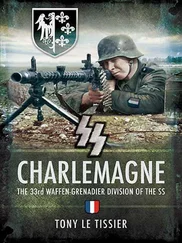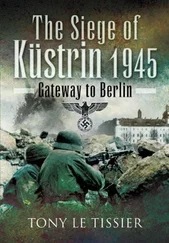Tony Le Tissier
WITH OUR BACKS TO BERLIN
The German Army in Retreat
1945
Leafing through the material I have accumulated from over twenty years of studying the Second World War Berlin battlefield scene, much of it ‘feedback’ from the German editions of my books, The Battle of Berlin 1945 and Zhukov at the Oder , I came across so many interesting, hitherto unpublished pieces that I decided to bring some of them together here as a collection of short stories.
These heroic, often poignant accounts of the desperate, last-ditch defence of the Fatherland should not be taken in any way as an apology for the German cause. It is precisely because one so seldom hears their side of the story, that they deserve a wider readership. They are mainly told by former members of the Wehrmacht and even the dreaded Waffen-SS, some of them still surviving. Perhaps surprisingly, the stories are characterised by the same individual human warmth and soldiers’ humour as you might normally expect from the ‘good guys’ – the GIs, British and Commonwealth infantry and armoured brigades, who had to contend with a surprising degree of resistance before ending the war in Europe. The lesson, I suppose, is that we are all pretty much alike, under the uniform.
With Allied forces – and, above all, the avenging Red Army of the Soviet Union – closing in on all sides; with their communications, fuel supplies and heavy industries under constant air attack, it is noteworthy that the German armed forces managed to maintain such an effective resistance. One has only to recall General Eisenhower’s decision not to attack Berlin after his forces had reached the line of the River Elbe, because of the anticipated 100,000 further casualties this might cost him. Field kitchens still operated. Dispatch riders still got through. Transfer orders were carried out. Drill parades were still held, even under the Russian shellfire. Eventually, as in W.B. Yeats’s famous line, ‘Things fall apart, the centre cannot hold’… and the rout began. But the patriotic determination of the individual German soldier to defend his Fatherland with skill and discipline even at the cost of his life was never in question. Author Christabel Bielenberg summarised the situation neatly in The Road Ahead :
Germany had nothing to be proud of during Hitler’s reign, but there were two outstanding exceptions. Firstly, the courage and tenacity of her soldiers when, inadequately equipped, they ultimately found themselves defending this country against the whole world. Secondly, the 20 July plot, when those who had taken part so nearly succeeded in ridding their country of a monster who had ruled over them for eleven years and who claimed their lives when they failed.
Only one of these stories covers the fighting on the Western front, where the US 94th Infantry Division had to breach the Siegfried Line in the severest of winter conditions, the infantry units suffering up to 500 per cent casualties. Despite bitter hand-to-hand combat, there was much mutual respect, as the stories about General Patton’s handling of the surrender of 11th Panzer Division and the snatching of the famous Vienna Riding Academy’s Lippizaner horses from under the noses of the Russians are included to show. (It is interesting to note that in the part of Germany that lies between the Moselle and Saar rivers, the Americans are still regarded as the ‘Liberators’…)
In ‘The Siege of Klessin’, which I compiled mainly from the regiment’s surviving radio ‘logs’ and the unit’s after-action report, one gets a vivid impression of the combat: the extraordinary heroism of the frontline troops, trapped in their positions, unable to retreat – and the basic futility of their military task, as ‘Corporal’ Hitler played out his doomed role of the ‘Greatest Field Commander of All Time’….
In the late Horst Zobel’s account of the tank battle for the bridge at Golzow, a small armoured unit with a hopeless mission pits its exceptional fighting skills against Zhukov’s seemingly limitless Soviet armoured forces. Erich Wittor describes an encounter with history and a Stuka ace at Kunnersdorf, and returns later with a longer account of the confused action at Marxdorf. Harry Schweizer recalls his experiences as a schoolboy anti-aircraft gunner posted to the Berlin Zoo flak-tower; and how, briefly, he got a taste of tank-busting with the SS. Gerhard Tillery gives us a rifleman’s account of the fighting in the Oderbruch, the retreat across Berlin and the eventual breakout of servicemen and civilians to the West. Karl-Hermann Tams describes the defence of Seelow, with a motley platoon of sailors and soldiers (who suffered over 90 per cent casualties) cowering under the greatest artillery bombardment in history. Rudi Averdieck, then a regimental radio sergeant, describes the harrowing retreat from Seelow to Berlin, and how he became involved with a newly-organised armoured brigade that had only one mission, to surrender to the Americans.
Quite properly, there are two Jokers in the pack. One is an account by Harry Zvi Glaser, a Latvian Jew who joined the Red Army and tells of his experiences at Halbe, where the remnants of the German 9th Army and its accompanying refugees suffered over 40,000 killed. (Harry, who became a US citizen, did not receive his medal until it was presented to him by President Yeltsin on a visit to the White House in 1995!) Finally, there is the insubordinate SS Sergeant Major Willy Rogmann, a born survivor (and the shortest man in his regiment) who, having ‘done his bit’ for Führer and Fatherland in some of the toughest theatres of the war, found himself leading an unlikely team of combatants through the ruins of Berlin, armed with a British Sten-gun (they didn’t jam, like the German Schmeissers).
These exciting ‘true tales’ beg the ultimate question: what might we have done, With our Backs to London, or even Washington?
A H Le T Frome, Somerset January 2001
The Oderbruch Battlefield
ONE
In the Steps of Frederick the Great
In 1945 Erich Wittor was a 20-year-old second lieutenant of three months’ standing, leading a squadron in the Armoured Reconnaissance Battalion ‘Kurmark’, commanded by Major Freiherr von Albedyll, only son of the squire of Klessin (see The Siege of Klessin). The Panzergrenadier Division ‘Kurmark’, to which his unit belonged, had yet to be fully formed on the basis of the Panzergrenadier Replacement Brigade of the famous Division ‘Grossdeutschland’. This brigade had been sent forward from Frankfurt under Colonel Willy Langkeit a few days earlier to try and help plug the gap caused by the collapse of the German 9th Army on the Vistula, and was now itself trapped immediately east of Kunersdorf. Marshal Zhukov’s troops, here elements of the 1st Guards Tank and 69th Armies, were rushing forward to close up to the Oder River, hoping to secure bridgeheads on the west bank before the ice melted.
On 1 February 1945, I received orders to take Kunersdorf, a village directly east of Frankfurt an der Oder. This was the Kunersdorf where Frederick the Great fought a battle against the Russians and the Austrians on 12 August 1759. On the very same ground the cavalry regiments under General von Seydlitz [1]had attacked and the dead-tired Prussian infantry advanced against vastly superior numbers of Russians. The battle was lost with immense casualties. Now we were standing on historical ground, having to fight for our country. Would we have any better luck?
Читать дальше













